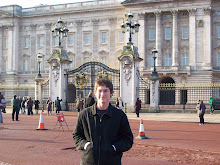
Monday, March 30, 2009
Walkabout

Sunday, March 1, 2009
Kostnice Sedlec




Wednesday, February 25, 2009
Solo Sojourn


Servus! That's Hungarian for "hello". This past weekend marked my first journey outside Prague that was not part of the AIFS program. Also, none of my comrades were able to join me so rather than miss out on a spectacular event, I decided to rough it and went by my lonesome.
Monday, February 16, 2009
New Home



Thursday, February 12, 2009
A Brief Tutorial
Monday, February 9, 2009
First Impressions


Hello folks! So where to begin? I’ll guess I’ll start with the first impressions I had when we rolled into Plzen on 01/31/09. Plzen was the only Czech town liberated by the Americans at the close of WWII and looks like it hasn’t aged a day since then. Rubble and debris lay in the mud surrounding crumbling buildings, their facades rife with peeling paint and graffiti. Off in the distance, the synagogue’s twin spires poked through a smoky haze. We had lunch at the Pilsner-Urquell brewery at the outskirts of town. This is probably the most renowned of the local beer companies and their green logo can be seen glimmering above the entrances of many bars and pubs. It’s good stuff but frankly I’m not much of a beer drinker so I have hard time comparing the quality to other Czech beers, although I’m sure my opinions will be more finely tuned at the close of my stay.

After a light lunch, we hopped back on the bus and made our way to Prague. I had fallen asleep as the bus was leaving Munich, so I went straight from seeing German billboards to Czech ones. My knowledge of German, rusty as it is, gave way to total bewilderment as I could only (barely) pronounce the Czech words I was seeing. Thus, I left behind Western Europe and all notions of familiarity as we headed into former Soviet territory. I love the sound of the Czech language, partly because it’s altogether different from any Romance language and partly because with out the context of comprehension, it sounds like musical gibberish. Reputedly, Czech is one of the hardest languages for non-native (and especially English) speakers to learn. Once I start my Czech Intensive language course, I’ll let you in on the particulars.
We rolled into Prague later that evening, and WOW, I was stunned at how beautiful the place was. It deserves the moniker of “city of a hundred spires” because in any direction you turn your head there are spires are poking holes in the sky. The place has an unspoiled age about it, a result of surviving both World Wars relatively intact. Though I only have London and Munich as reference points, Prague strikes me as the most quintessential European city, with its winding cobblestone roads, statues jutting out of the sides and tops of buildings, and the plethora of sophisticated culture at one’s fingertips. There’s more museums, galleries, shops, and restaurants than one could hope to visit in a year. I look forward to my time spent here. Crossing the Charles Bridge is a breathtaking view what with Prague Castle overlooking the city like a benevolent sovereign. Suffice to say, I feel at home here. That’s all for today.



























